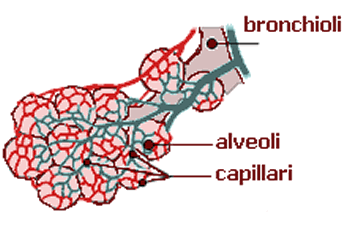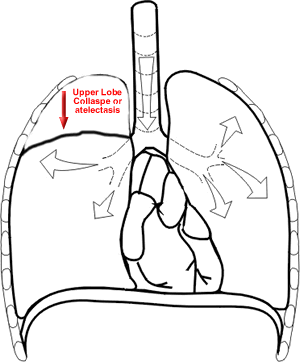|
ATELECTASIS Atelectasis is a term used to describe a collapsed area or "airless" area of lung. Air travels from the windpipe (called the trachea) and enters the right or left bronchus. From the two main bronchi, the air passages branch into smaller tubes called bronchioles. At the very end of the air passages are clusters of small air filled sacs called alveoli (singular: alveolus). These air sacs are surrounded by tiny blood vessels called capillaries (Image 1). When fresh air containing oxygen enters the alveoli, the oxygen is able to move into the capillaries to be carried back to the left side of the heart. Normally, the alveoli remain open all the time. Problems can occur that can make the alveoli close. Fluid (edema) around alveoli, secretions in the airway or fluid or air in the sac around the lung can put pressure on the alveoli and make them collapse. Because oxygen cannot enter alveoli that are collapsed, alveolar collapse causes the concentration of oxygen in the blood to fall. Airless areas of lung are called atelectic areas. Secretions (phlegm) in the airway can cause segments of the lung to collapse and become atelectic. Chest physiotherapy and/or position changes are sometimes helpful at reopening (re-expanding) collapsed area of lung. |
Image 1: Normal inflated alveolus, surrounded by capillary. |
|
Image 2: Collapsed and airless (atelectic) area. |
|
|
|
|
|
|
|
|
|
|





